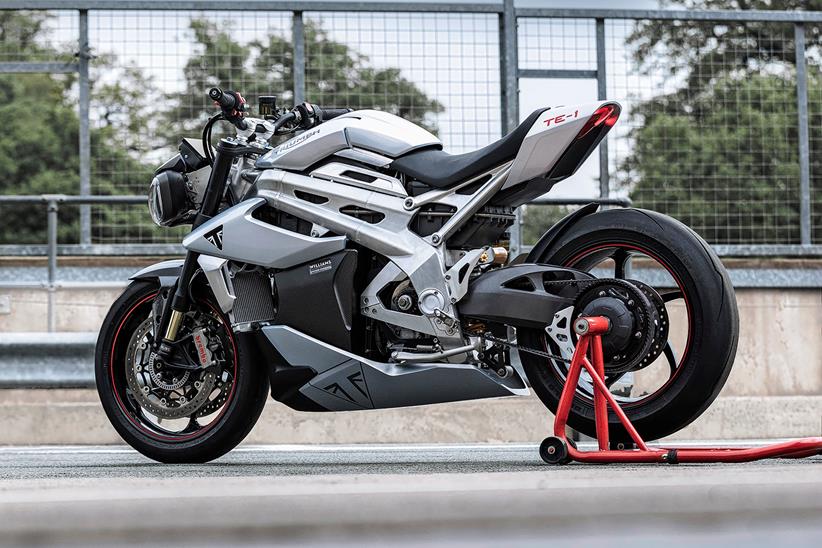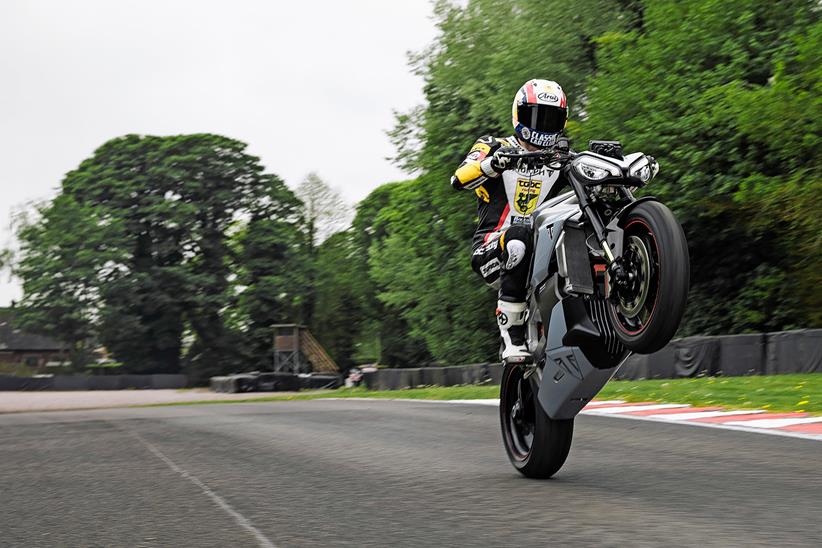Triumph's TE-1 wins Best Electric Bike at GQ Car Awards
Triumph Motorcycles’ electric prototype TE-1 has won the “Electric Motorbike of the Year” award at the 2023 GQ Car Awards.
Triumph unveiled the prototype in 2019 as a collaboration between Williams Advanced Engineering, Integral Powertrain and Warwick Manufacturing Group (WMG) at the University of Warwick, with funding by the Office for Zero Emission Vehicles.
In finished trim Triumph say the TE-1 will weigh a hair over 220kg, will produce 174bhp and will travel around 120 miles before you need to plug it in.

Paul Henderson, one of the judges said: “With a 0–60mph time of 3.6 seconds, top speed of 135mph, a 100-mile range on a single charge, and a 0-to-80% charge time of just 20 minutes, Triumph’s first fully electric prototype has exceeded all expectations to set new standards in the sector.”
He added: “Triumph says they have no plans to put the TE-1 into production, but the technological advances, battery development and electronic breakthroughs will all feature in the British motorcycle brand’s next gen (or should that be first gen) production EV. In other words, the best is yet to come.”
Steve Sargent, Chief Product Officer at Triumph Motorcycles, said: “We are delighted to have our efforts in developing an exciting, high performance electric motorcycle recognised at the GQ Car Awards.
“There are significant challenges in bringing electric motorcycles to the mass market, but the TE-1 is a crucial step towards Triumph’s development and understanding of electric vehicle technology.”
Triumph TE-1 wows at Oulton Park with electric production models now in development
First published 12 July, 2022 by Dan Sutherland
Triumph have announced the end of their TE-1 electric motorcycle development programme by producing an aggressive 175bhp sports naked capable of hitting 100mph faster than a combustion-engined Speed Triple 1200RS.
But, before you go reaching for your credit card, the TE-1 will never go into production – instead serving as an educational tool to allow the Hinckley firm to build what they believe to be viable electric motorcycles for future production.
“We’ve got decades of experience now doing combustion-engined bikes,” Chief Product Officer, Steve Sargent told MCN ahead of the official reveal. “But, quite clearly, the world is moving to electric, and we wanted a vehicle for us to not just build our knowledge, but also show our expertise in being able to develop something completely fresh.”
The previous update to the project – known as ‘phase three’ – was shared back in February, with the latest update providing final performance figures following an Oulton Park track test by double Daytona 200 winner Brandon Paasch and countless hours on a rolling road.

“I got to peg this thing all the way from zero to 100% throttle and it’s unbelievably quick, it pulls like crazy,” the American racer said. “I think this would be a really nice motorcycle to ride on the street, just based on how nimble and agile it is, and how light it feels.”
The TE-1 has been designed to share the ergonomics, feel, and weight distribution of the existing 1200RS super-naked and Triumph say the figures they have been able to achieve have exceeded expectation.
This includes a 100-mile range when ridden spiritedly on a mixture of A roads and motorways, with regenerative braking on hand to extend the battery capacity.
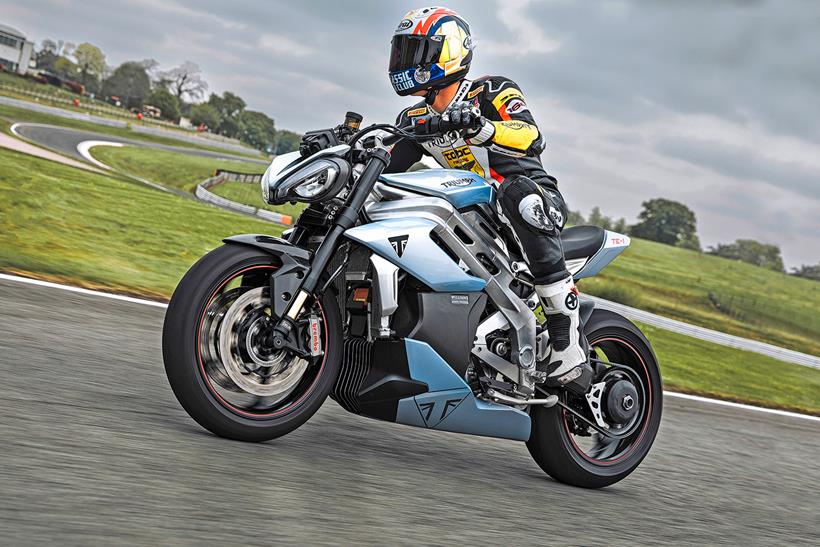
What’s more, Triumph say it will also do a full trackday session when ridden at fast-group speeds, with a 0-80% recharge time of 20 minutes. The whole bike weighs in at a claimed 220kg – 22 kilos more than a fully fuelled Speed Triple, but 4.5kg less than Ducati’s V21L prototype, which is being developed for next year’s MotoE race series and providing a testbed for future Bologna-built battery bikes.
“We know that we could make improvements to the cooling system that would give us more performance out of the battery,” Sargent continued. “We know there are things that we could do with the structure of the battery, and we know there’s potential to get more from the motor.
“But when we’re saying improvements, we’re not talking about getting another 50% [more performance] quickly – it’s not that kind of speed of development.”
Into production
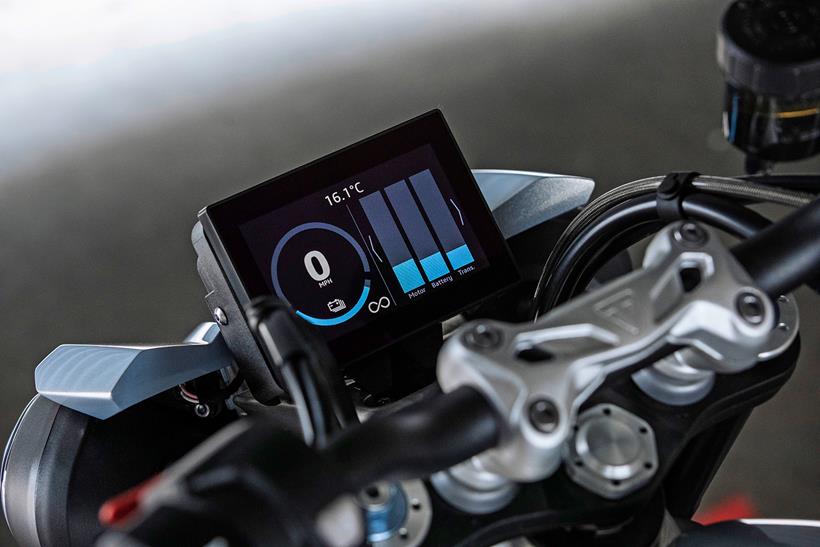
Just because the TE-1 is sporty, it won’t mean future production bikes will follow suit. Sargent said: “A lot of the guys who have been working on this project are now moving on to work on our production electric vehicles. We already have bikes on the drawing board now that the guys are starting to develop.
“As a brand, we don’t make utilitarian vehicles, we don’t have a scooter to go down to the shops on. It will be something that’s a Triumph. It will be an electric Triumph, but it won’t be this.
“It doesn’t have to be a scooter or superbike. Quite clearly, there’s a range of products between those two and I think that is where you’ve got to see where the opportunity can be.” Exactly how that will look remains to be seen at this time. We’ll keep you posted on progess,” says Sargent.
Triumph explore other energy solutions
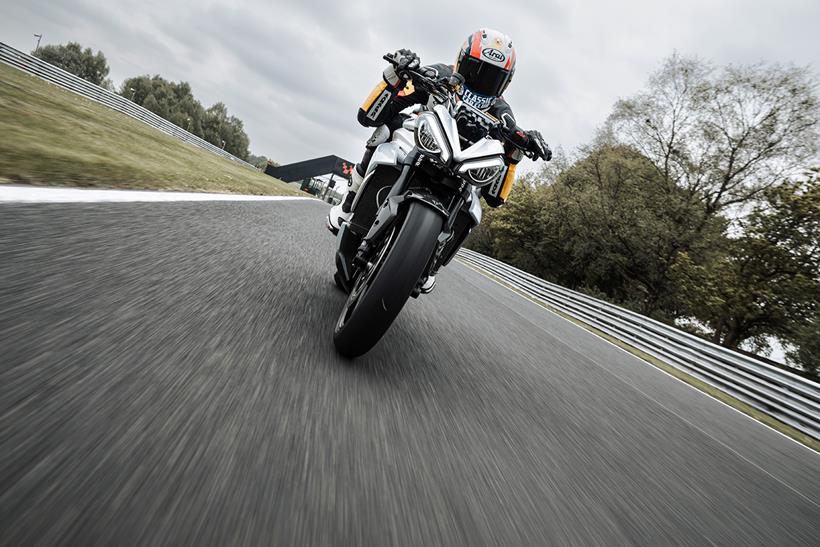
Despite the efforts put into the TE-1, electricity isn’t the only alternative power source the British brand are considering for the future of their motorcycle ranges.
“There’s an ambition in the racing world in particular to start moving towards synthetic fuel,” Steve Sargent told MCN. “As the engine supplier to Moto2 we’ve been party to those discussions, and we have already done some testing on synthetic fuels.
“I guess the question is, ‘can you make it in bulk at the price that people are happy to pay?’,” he added. “Quite clearly, it gives you another option to purely electric vehicles. As we said previously, there are challenges around doing large capacity electric vehicles.
“Could synthetic fuels be the answer? Maybe. We can’t count it out. Could hydrogen combustion be the answer? Possibly – again we can’t count it out. We’re definitely not putting all our eggs in one basket, but we do know that there are a range of electric bikes that are viable, so the learning from [the TE-1] will build into those. Will all of our bikes go electric, or will some of them go a different direction? Maybe so.”
Triumph get a helping hand
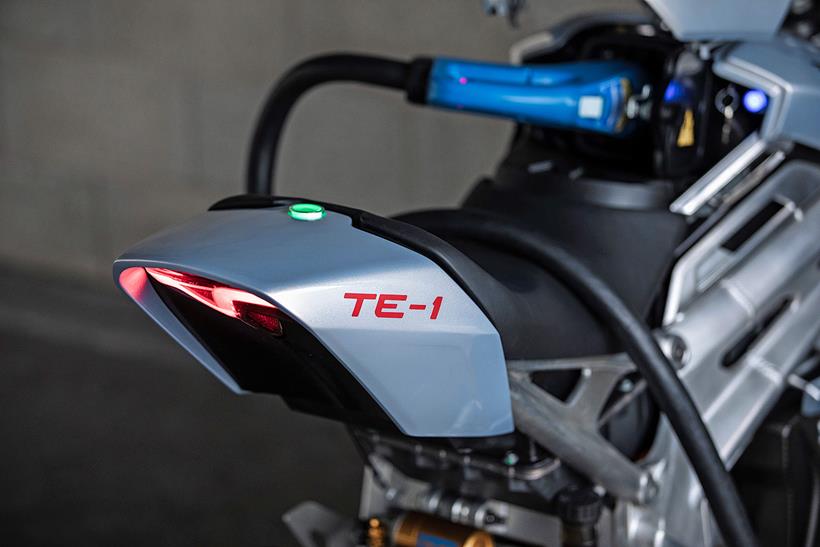
Triumph haven’t delivered the TE-1 project on their own. Although taking care of the styling, chassis, finish, and overall planning, they have been joined by key industry players to broaden their knowledge of the electric bike market.
Taking care of the battery and integration was Williams Advanced Engineering, who got involved back in 2018. Joining them was Integral Powertrain Ltd’s e-Drive division who created a scalable power-dense electric motor that achieved peak and continuous power densities of 13kW/kg and 9kW/kg respectively and a silicon carbide invertor in one 15kg unit.
This scalable system is said to be capable of 670bhp, should you want it, so producing power isn’t an issue. WMG at the University of Warwick helped with the modelling and simulation of the bike, with the Government’s Office for Zero Emission Vehicles and Innovate UK providing additional support and funding to the project.
Triumph TE-1 prototype takes Speed Triple from three-cylinders to three-pin plug
First published on 8 February, 2022 by Jordan Gibbons
Triumph have unveiled phase three of their TE-1 electric project with a complete bike that clearly resembles their trademark Speed Triple.
The end of phase three marks the conclusion of the collaborative stage of the project, which has seen Triumph work with Williams Advanced Engineering, Integral Powertrain and WMG at the University of Warwick. Stage four will be solely undertaken by Triumph and will take it from this ready-to-roll bike to a fully rideable prototype.
Related articles on MCN
- Best electric motorcycles
- Swappable battery tech on the horizon
- False ecology? The truth about electric motorbikes and the environment
The last update from the project was in March last year, when Triumph unveiled the battery unit as well as key specs – namely: 220kg weight, 174bhp, 120-mile range and a 0-80% recharge in just 20 minutes. Since then, each of the different groups involved in the project has been beavering away to ensure the complete machine is a game-changer.
From Triumph’s perspective this has meant finishing the frame and selecting the ancillary components such as brakes, suspension and other running gear.

“During phase three of the project we have focused on building the physical foundation of Triumph’s first electric prototype,” says Steve Sargent, Triumph’s Chief Product Officer.
“I am pleased with the outcome of Triumph and the TE-1 partners’ efforts in creating a demonstrator bike that is not only visually so desirable with clear Triumph DNA, but also packaged with an exhilarating and thrilling brand-new electric powertrain that has such potential for the future,” he continued.
Of course all the testing in the world isn’t the same as throwing a leg over it, which is what Triumph see as being the really important next step. To really nail the handling, in phase three Williams have been refining the internal architecture of the battery pack to ensure the bike has the optimum centre of gravity as well as finishing the charging components.
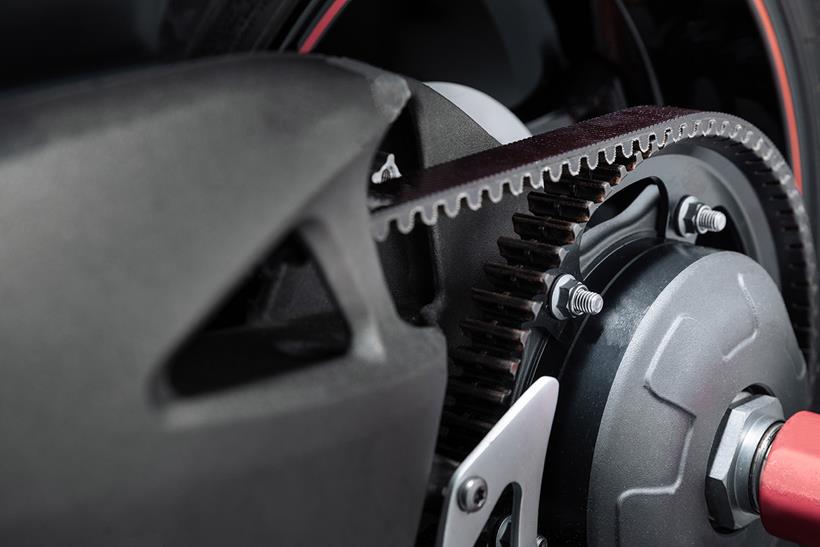
“Because we have designed the battery from the ground-up, design has not been compromised and we have been able to push the boundaries of current technology, offering both performance and all important, range,” says Dyrr Ardash, Head of Strategic Partnerships at Williams Advanced Engineering.
Paired with the battery changes, Integral Powertrain have also been fine tuning the motor and inverter, which now has a peak power density of 13kW/kg and continuous of 9kW/kg. Most importantly the motor could now be placed into volume production. Interestingly there’s the option for (a lot!) more power if they want it.
“The inverter concept, which is also scalable by tuning the number of silicon-carbide power stages for different diameter motors, has really delivered on performance,” says Andrew Cross, Chief Technical Officer at Integral Powertrain. “The TE-1 unit is capable of over 670bhp.” Perhaps a bit much…
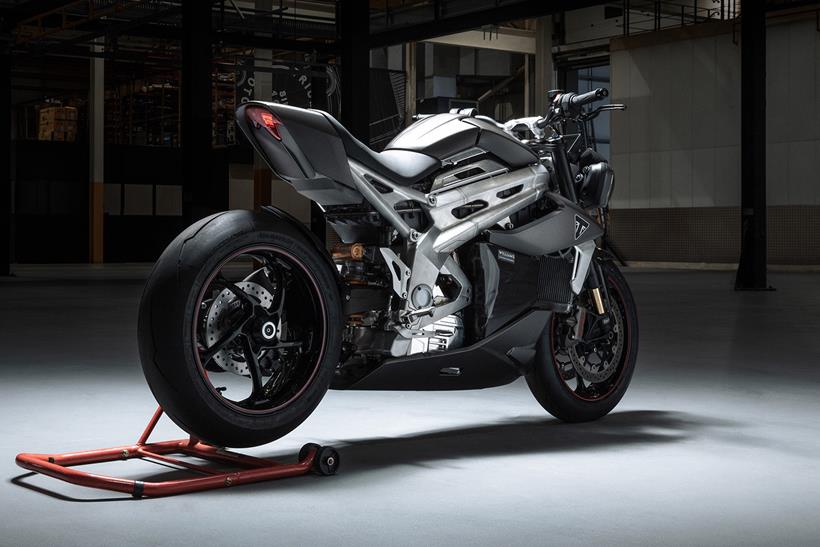
One of the final pieces of the puzzle for the project has been the evaluation done by WMG. Their modelling work not only ensures that everything works well before it’s built but also allows for advanced simulations that mean many real-world riding scenarios have already been encountered, so the bike should be well behaved by the time it hits the road.
Interestingly, WMG also say they’ve been looking at the potential for a dedicated motorcycle charging network, with the studies given over to the Government to help support electric bike adoption.
So what’s next? Phase four begins now and will last approximately six months, during which time Triumph will do live testing of the prototype. This will start with slightly dull stuff – calibrating the throttle on a dyno or testing the validity of the software – but will quickly progress to much more exciting things such as track testing where they’ll test the limits of the traction and wheelie control.
With that complete, they’ll confirm all the stats are right, then consider the next phase – an actual production bike for release.
Triumph TE-1 electric bike promises genuine super-naked performance without hours spent at a socket
First published on 24 March, 2021 by Jordan Gibbons
Triumph have revealed key details of their TE-1 electric bike project, which not only looks amazing but also boasts tech and performance figures that could tempt even the most die-hard petrolhead.
Related articles on MCN
- Best electric motorcycles
- Swappable battery tech on the horizon
- False ecology? The truth about electric motorbikes and the environment
Working with an array of British companies, including Williams Advanced Engineering, Integral Powertrain and Warwick Manufacturing Group (WMG) at the University of Warwick, and funded by the Office for Zero Emission Vehicles, Triumph have created a prototype that has the power to challenge what we think about electric bikes. Before we get to the details though, let’s look at the headline figures.
In finished trim Triumph say the TE-1 will weigh a hair over 220kg, will produce 174bhp and will travel around 120 miles before you need to plug it in.
In short, it’s a portly Speed Triple but we’ve not even told you the really positive news yet: The TE-1 will be capable of a 0-80% charge in just 20 minutes. If you’d limped into a charging station when you started reading this, the bike would already have added five miles to its range.
Now it’s been officially revealed, is the Triumph TE-1 concept the bike that will convince you to give electric motorcycles a go? To have your say, press an option below. For more information, click here: https://t.co/avCqiZE5Pn — Motor Cycle News (@MCNnews) March 23, 2021
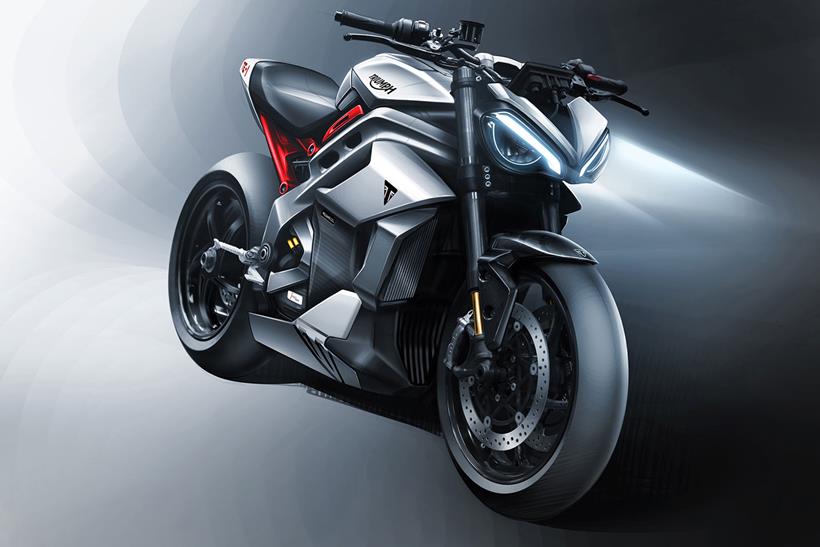
In the battle to convince more people to take up electric, a key part of keeping aggressive green legislation away from two wheels, it’s a huge stride forward and something Triumph are well aware of.
“What we wanted to do was investigate how you could create an electric bike that would convince somebody to consider an electric bike, or even move them away from something with an internal combustion engine (ICE),” says Steve Sargent, Triumph’s Chief Product Officer.
“To do that we have to understand the customer, how they use their bikes and what they’d want from their bikes. For electric bikes to grow, it has to be a natural choice for someone because the bike is desirable in its own right.”
Interestingly Triumph appear to have skipped the whole ‘you can ride it to work for less than a bag of chips’ angle, instead focusing on how the TE-1 could be a weekend plaything. Despite that, they’re keenly aware of the cost of similar competitors.
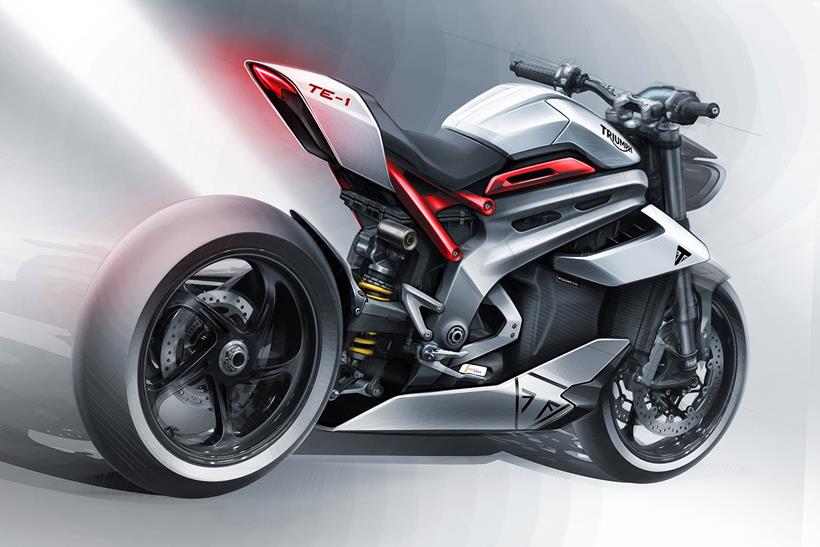
“The challenge is that people want something that gives them the performance of an internal combustion engine bike but they don’t want to pay a huge premium,” adds Sargent.
“For us, it has to be at a price point where there’s enough people willing to pay for it. Whilst battery costs are coming down, they’re still expensive, so the bike will come to market when we can get it down to a price that we think people are willing to pay.”
So what’s next? This reveal is phase two of the project (phase one – the initial announcement – was in May 2019) with Triumph saying that phase three, likely to be a preview of the prototype they’re now testing, is expected in October.
After TE-1 the sky’s the limit, with Sargent hinting at the scalable potential for torquey applications like the Rocket, while Triumph’s CEO, Nick Bloor, has said the TE-1 is “one of the foundations for our future electric motorcycle strategy”. This bold first reveal shows Triumph intend to be an electric super-power.
Triumph TE-1 electric bike technical detail
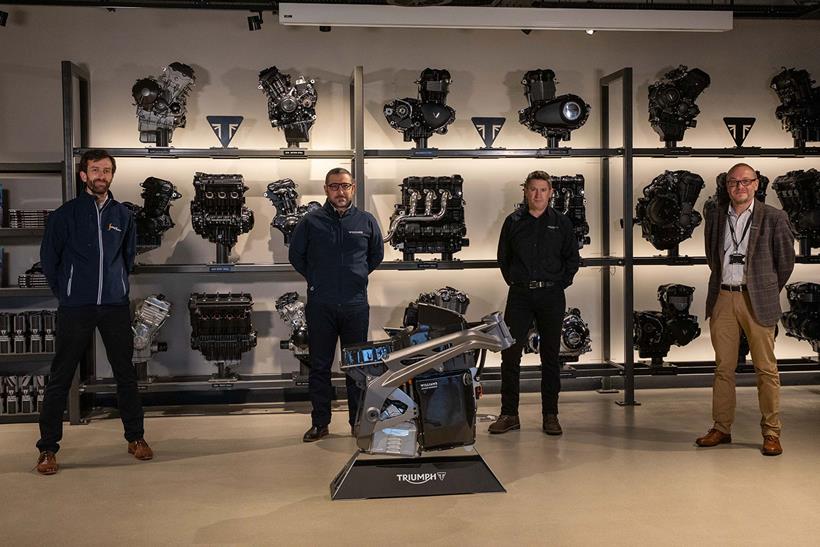
The TE-1 project has been a huge team effort, bringing together British companies that have long histories in engineering excellence along with funding from the government.
With each concentrating on a specific area where they already have experience – Triumph the chassis, Williams the battery, Integral the motor and WMG the computer modelling – Triumph have been able to work towards something far greater than they likely could have achieved on their own. Here the other key partners reveal the parts of the project they’ve developed.
Tech from Formula E
Williams have experience designing and building batteries for everything from Brompton bicycles to Airbus planes. For the TE-1, Williams have created the battery, which employs new architecture, as well as the vehicle controller and associated software.
“We’ve taken a lot of our existing tech from motorsport, such as Formula E, and utilised the next generation cell technology to meet the attributes required by a Triumph rider,” says Dyrr Ardash, Senior Commercial Manager, Williams Advanced Engineering.
“The capacity is approximately 15kWh but that’s not the whole story, as we’ve managed to optimise it to give a 120-mile range and a charge time of under 20 minutes to 80% from zero. The battery also delivers the same performance 100-0% thanks to good thermal management and our control system, which has been found through simulations.
“The biggest challenge for us,” reveals Ardash, “was that we were pushed quite hard by Triumph to maintain the correct centre of gravity, which we needed for the right handling attributes.”
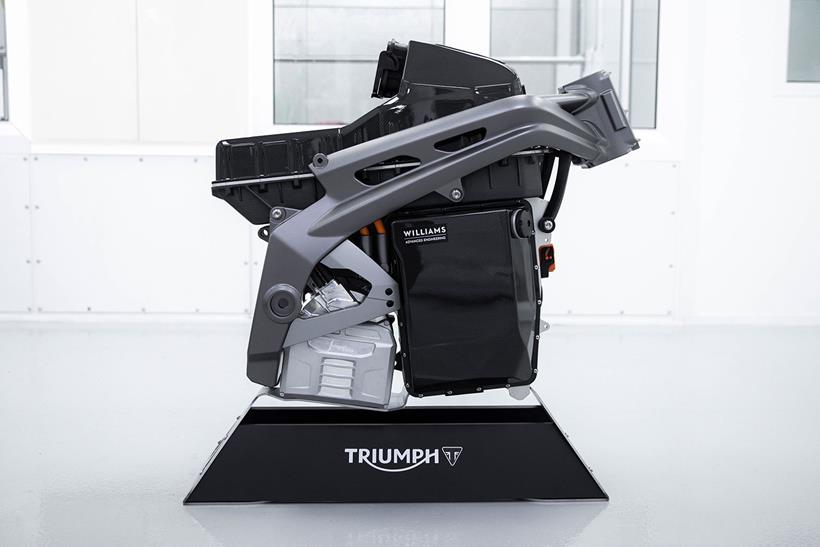
Lightweight electric motor
Integral are no strangers to performance electric motors, having built the motors and inverters for VW’s I.D R race car which set outright records at Pikes Peak and Goodwood Festival of Speed.
Although two wheelers are new to Integral, their motor and inverter package for the TE-1 claims new standards for electric bikes producing nearly 175bhp but weighing just 10kg.
“We started quite freely but it quickly became clear the motor needed to be very small to maximise the room for the battery inside the bike,” says Andrew Cross, Chief Technical Officer at Integral Powertrain.
“A key part of that for us was packaging up the motor with the inverter [the bit that changes DC to AC].
“The other key bit was maximising the efficiency with our motor achieving 97% and the inverter nearer 99%. These motors use switches that open and close very quickly. Each time you open and close a switch, you create a loss.
“The switches in this motor use silicon carbide, which is a compound semi-conductor, and more efficient than typical switches, meaning every time the switches open and close, this motor loses less energy than a typical motor. This means you either get a greater range for a given amount of energy, or can potentially reduce the battery size.”

Development through simulation
WMG (University of Warwick) will be a familiar name to many bikers due to their recent Aurora electric superbike project, but they have been around since 1980. As well as bringing together suppliers, thanks to their expertise, WMG have built simulations of the TE-1, allowing countless hours of testing before anyone has even turned a wheel.
- Related: Aurora electric superbike project
“In the old days when you developed a new product you’d build it, then test it but if you want to make any changes, you have to start all over again,” says Phil Whiffin, Head of Advanced Propulsion Systems at WMG.
“We are able to simulate the rider, the motorbike, the environment and the drive cycle. Triumph were able to set out their targets and through simulation, we could work out what the specifications would have to be to meet that.
“Straight away you can see if what you want to build is feasible. We built a ‘hardware in the loop’ set up, and the simulator can feed info to the sensors, ECU etc so they all believe they are on a motorbike that’s out on the road. The result is that you can make hundreds of changes quickly and without the expense.”
Triumph shock! Brit firm announce TE-1 electric motorbike collaboration project
First published on 15 May, 2019 by Richard Newland
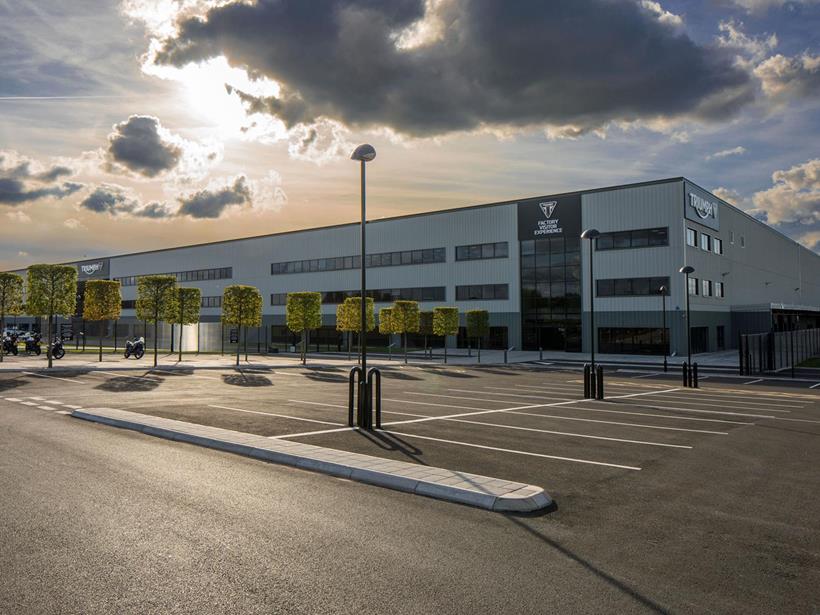
Triumph have announced a ground-breaking plan to accelerate the addition of electric motorcycles to the range in collaboration with other key UK innovators, including Williams Advanced Engineering.
Related articles on MCN
- Best electric motorcycles
- Troubleshoot bike problems by noise
- Triumph Rocket 3 GT production bike spotted
The project, dubbed TE-1, will target the rapid evolution of powertrain solutions over the next two years, with a view to developing a light, compact battery-powered drive unit that will power a new generation of Triumph motorcycles.
While TE-1 might sound like a bike model, Triumph have confirmed to MCN that this project is focused on battery technology, motors and the packaging constraints that currently hinder electric motorcycles – not building a specific single model.
The tie-in with F1 legends, Williams, is key to the project’s success, with the firm able to provide industry-leading lightweight battery design and integration capabilities. Other partners include motor and inverter experts, Integral Powertrain, the electric specialist team at the University of Warwick – WMG – and government funding via the Innovate UK science and technology agency.
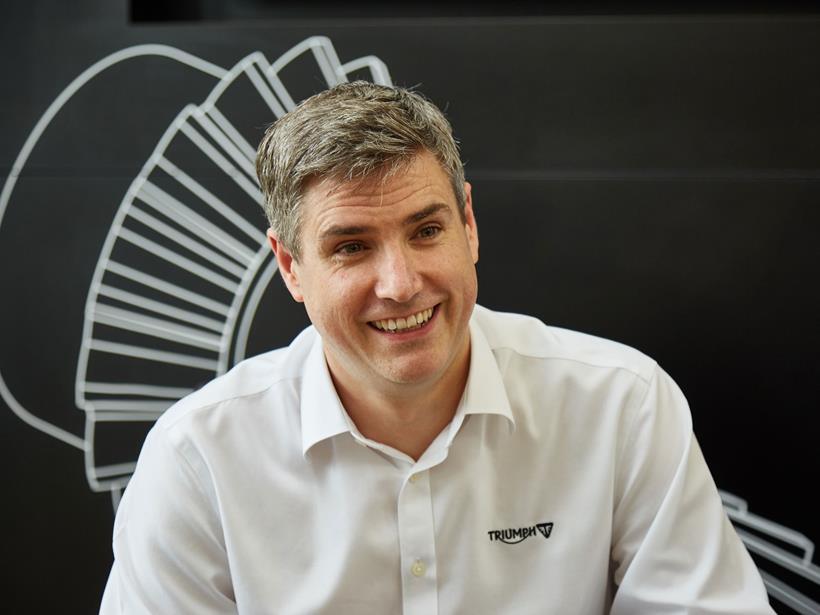
“This new collaboration represents an exciting opportunity for Triumph and its partners to be leaders in the technology that will enable the electrification of motorcycles,” said Triumph CEO, Nick Bloor, “which is driven by customers striving to reduce their environmental impact, combined with the desire for more economical transportation, and changing legislation. Project Triumph TE-1 is one part of our electric motorcycle strategy, focused on delivering what riders want and expect from their Triumph, which is the perfect balance of handling, performance and usability.”
And therein lies the crux of the project’s importance to Triumph. This isn’t a project aimed at rushing a wildly expensive, or under-performing electric bike into the marketplace in order to tick a box. Triumph are determined that customers will be able to make like-for-like decisions about which bike to buy regardless of the powertrain. In the future this could mean having the choice of a petrol or electric Street Triple – with no overt compromise to either choice.
Steve Sargent, Triumph’s Chief Product Officer added “Our future product strategy is focused on delivering the most suitable engine platforms for the changing landscape of customer needs, and we see a Triumph electric powertrain as a significant requirement alongside our signature twin and triple cylinder engines. Project Triumph TE-1 represents an exciting collaboration that will provide valuable input into our future line-up.
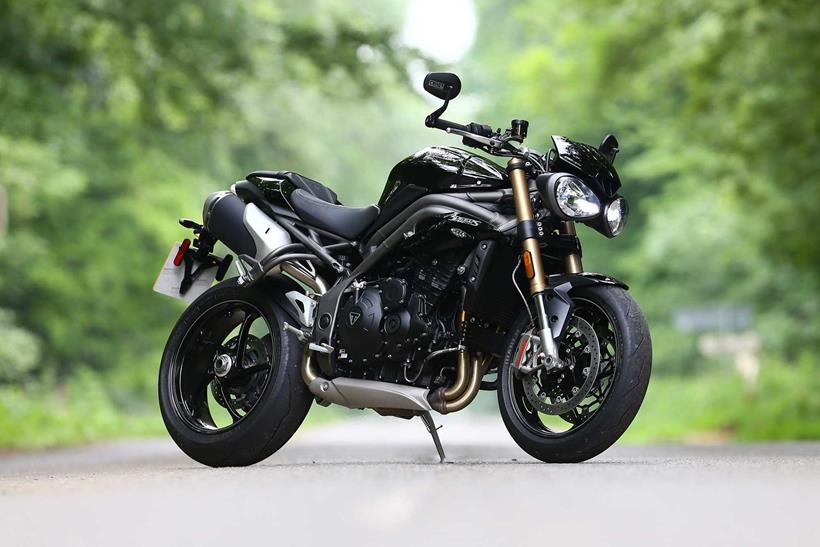
Imagine an electric Speed Triple…
“We are incredibly pleased to have the support of OLEV and Innovate UK, and to be working together with the UK’s electrification experts and academic leaders, in an endeavour that ultimately is focused on the future prosperity of British industry, and the future of motorcycling.”
While the project will aim to lead to model development, this is still several years in the future, with this first phase aiming to deliver powertrain solutions in two years’ time, ahead of any specific model development starting in earnest.
One key aim is increased systems integration, developing individual components of automotive-based electric drivetrains and optimising them for motorcycle systems which reduce mass, complexity and packaging requirements.
Triumph have become the masters of packaging in recent years, and will work alongside the partners to accelerate the safety of batteries, optimum electric motor sizing and packaging, the integration of braking systems including regenerative braking, and advanced safety systems. The innovation and capabilities developed in these areas will input into Triumph’s future electric motorcycle strategy.
“The team at Williams Advanced Engineering is looking forward to applying our expertise in the electrification of transport with our partners,” said Craig Wilson, Managing Director of Williams Advanced Engineering. “Williams has powered a number of world-renowned electric vehicles already and this will be a significant further step in our work by taking that knowledge onto two wheels.”
“We are extremely pleased to be supporting Triumph Motorcycles with their future electrification strategy and in a project where we can apply our experience to engineer an extremely power dense, efficient and highly integrated motorcycle electric drive,” added Andrew Cross, Chief Technical Officer at Integral Powertrain Ltd.
“Electric motorcycles will have a vital role to play in future transport across the globe – delivering reduced congestion and improved urban air quality as well as easing parking,” added Professor David Greenwood, Professor, Advanced Propulsion Systems at WMG, University of Warwick. “They will also be great to ride, with copious, easily controlled torque delivered smoothly at all road speeds.”
The Triumph TE-1 electric motorcycle project: who does what?
- Triumph will lead the project with their chassis design and packaging expertise and manufacturing infrastructure
- Williams Advanced Engineering will look after the lightweight battery design and its integration with the project, including a control unit that links to the bike’s main wiring system
- Integral Powertrain Ltd’s e-Drive Division will take care of the electric motor and invertor, which will be housed in a single casing
- WMG, at the University of Warwick, are going to lead the innovation required to get the project from R&D through to a finished product by simulating future market requirements
- Innovate UK will support partners and administer funds on behalf of the Government with the aim of making the UK a market leader in electric vehicle technology

